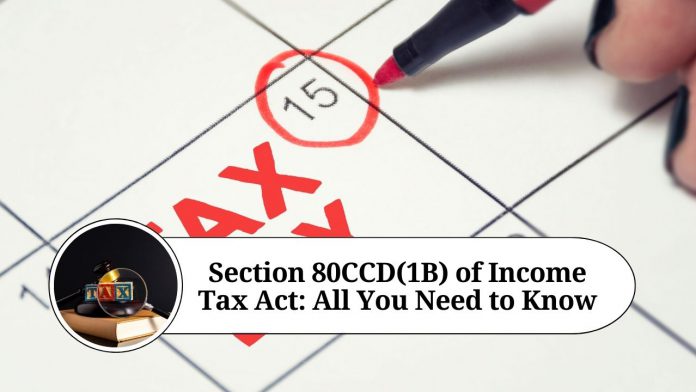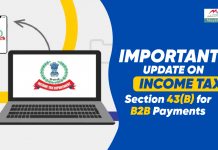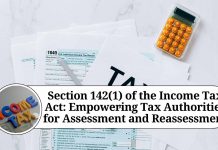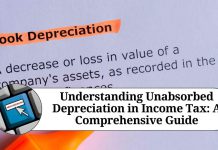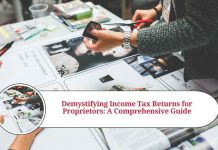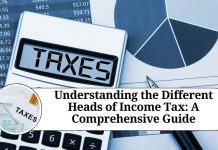Introduction
Section 80C of the Income Tax Act provides tax benefits to taxpayers for certain investments made during the year. However, section 80CCD(1B) is an additional deduction that taxpayers can claim for contributions made towards their National Pension System (NPS) account. In this blog, we will discuss Section 80CCD(1B) in detail.
Understanding Section 80CCD(1B)
Section 80CCD(1B) was introduced in the Income Tax Act in 2015. This section allows an additional tax deduction of up to Rs. 50,000 for contributions made to the NPS account. This is over and above the deduction of Rs. 1.5 lakhs available under section 80C.
Who can claim this deduction?
Any individual taxpayer who contributes to the National Pension System can claim a deduction under section 80CCD(1B). This includes salaried employees, self-employed individuals, and non-resident Indians (NRIs).
How to claim the deduction?
To claim the deduction under Section 80CCD(1B), the taxpayer needs to make contributions to their NPS account. The contribution can be made either by the employee or by the employer. The deduction can be claimed by the taxpayer at the time of filing their income tax return. The amount of deduction claimed cannot exceed the amount of contribution made during the financial year.
Tax benefits of Section 80CCD(1B)
The tax benefits of Section 80CCD(1B) are significant. The additional deduction of up to Rs. 50,000 is over and above the deduction available under Section 80C. This means that a taxpayer can claim a total deduction of up to Rs. 2 lakhs (Rs. 1.5 lakhs under Section 80C and Rs. 50,000 under Section 80CCD(1B)).
Benefits of investing in NPS
Apart from the tax benefits under Section 80CCD(1B), investing in NPS has several other benefits. Firstly, NPS provides a pension at retirement, which can provide financial security to the taxpayer. The pension amount is based on the contributions made and the returns earned on the investments made by the NPS fund manager. Secondly, NPS offers a choice of investment options, including equity, corporate bonds, and government securities, which allows the taxpayer to choose a plan that suits their risk appetite. Lastly, NPS is regulated by the Pension Fund Regulatory and Development Authority (PFRDA), which ensures transparency and accountability in the management of the funds.
Eligibility to invest in NPS
Any Indian citizen between the age of 18 and 65 years can invest in NPS. NRIs are also eligible to invest in NPS, subject to certain conditions. An individual can open an NPS account with any of the authorized entities known as Point of Presence (POP), which includes banks, post offices, and other financial institutions.
Tax treatment of NPS withdrawal
When the taxpayer retires or reaches the age of 60, they can withdraw a portion of the NPS corpus as a lump sum, subject to certain conditions. The lump sum withdrawal is taxable as per the applicable tax slab. The remaining amount must be used to purchase an annuity, which provides a regular pension to the taxpayer. The pension income received from the annuity is taxable as per the applicable tax slab.
Difference between Tier I and Tier II accounts in NPS
NPS offers two types of accounts – Tier I and Tier II. Tier I account is the primary account that is mandatory to open when enrolling in NPS. The contributions made to the Tier I account are locked in until retirement or the age of 60. The contributions made to the Tier I account are eligible for tax deductions under Section 80C and Section 80CCD(1B). The withdrawals from the Tier I account are subject to the annuity purchase rules mentioned above.
The Tier II account, on the other hand, is a voluntary account that can be opened only after opening a Tier I account. The contributions made to the Tier II account can be withdrawn at any time, and there are no lock-in periods. However, the contributions made to the Tier II account are not eligible for tax deductions. The Tier II account can be used as a savings account for short-term goals or as a means to invest in other financial instruments.
Conclusion
Section 80CCD(1B) is a valuable tax-saving provision for taxpayers who contribute towards their NPS account. The additional deduction of up to Rs. 50,000 can significantly reduce the taxpayer’s tax liability. Therefore, taxpayers should take advantage of this provision and plan their investments accordingly.
Read more useful content:
- section 145 of income tax act
- section 10e of income tax act
- section 9 of the income tax act
- section 94b of income tax act
- section 206aa of income tax act
Frequently Asked Questions (FAQs)
- What is Section 80CCD(1B) of the Income Tax Act?
Section 80CCD(1B) is a provision in the Income Tax Act that allows an additional tax deduction of up to Rs. 50,000 for contributions made towards the National Pension System (NPS).
2. Who is eligible to claim a deduction under Section 80CCD(1B)?
Any individual taxpayer who contributes to the National Pension System can claim a deduction under Section 80CCD(1B). This includes salaried employees, self-employed individuals, and non-resident Indians (NRIs).
3. How much tax deduction can one claim under Section 80CCD(1B)?
The maximum tax deduction that can be claimed under Section 80CCD(1B) is Rs. 50,000 per year. This is over and above the deduction available under Section 80C.
4. Can the deduction under Section 80CCD(1B) be claimed by both employees and employers?
Yes, both employees and employers can claim a deduction under Section 80CCD(1B). However, the total deduction claimed by the employee and employer cannot exceed the amount contributed to the NPS account.
5. What is the National Pension System (NPS)?
The National Pension System (NPS) is a retirement savings scheme introduced by the Government of India. It is regulated by the Pension Fund Regulatory and Development Authority (PFRDA) and offers a choice of investment options, including equity, corporate bonds, and government securities.
6. What is the lock-in period for contributions made to the NPS account?
The contributions made to the Tier I account of the NPS are locked in until retirement or the age of 60. The contributions made to the Tier II account can be withdrawn at any time.
7. Is the pension income received from the NPS taxable?
Yes, the pension income received from the NPS is taxable as per the applicable tax slab.
8. Can NRIs invest in NPS?
Yes, NRIs are eligible to invest in NPS subject to certain conditions. The contributions made by NRIs towards NPS are taxable in India.
9. What is the difference between Tier I and Tier II accounts in NPS?
The Tier I account is the primary account that is mandatory to open when enrolling in NPS. The contributions made to the Tier I account are locked in until retirement or the age of 60. The Tier II account is a voluntary account that can be opened only after opening a Tier I account. The contributions made to the Tier II account can be withdrawn at any time, and there are no lock-in periods.
10. Can one contribute to the NPS account after the age of 60?
Yes, one can continue to contribute to the NPS account even after the age of 60. However, the contributions made after the age of 60 are not eligible for tax deductions.

